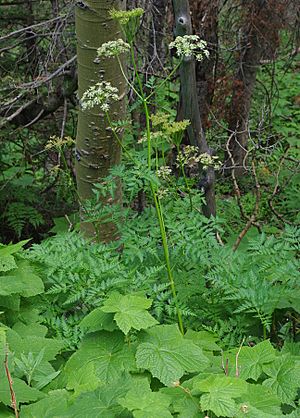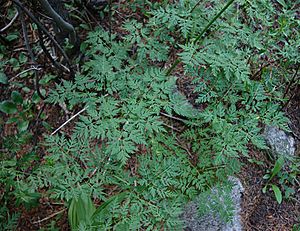Oshá facts for kids
Quick facts for kids Oshá |
|
|---|---|
 |
|
| Scientific classification | |
| Kingdom: | |
| (unranked): | |
| (unranked): | |
| (unranked): | |
| Order: | |
| Family: | |
| Genus: |
Ligusticum
|
| Species: |
L. porteri
|
| Binomial name | |
| Ligusticum porteri Coult. & Rose
|
|
Ligusticum porteri, also known as oshá (pronounced o-SHAW), is a plant that grows year after year. You can find it in parts of the Rocky Mountains and northern Mexico, especially in the southwestern United States.
Contents
Where Oshá Grows
Oshá is a mountain plant. It likes deep, wet soil that has lots of natural material in it. The plant also needs some shade, not full sun.
You can find Oshá all over the Rocky Mountains and in the tall mountains of northwestern Mexico. It grows best high up in the mountains, in what's called the subalpine zone. In the southern areas, it grows between 7,000 and 10,000 feet high (about 2,100 to 3,000 meters). But in Utah and Wyoming, it can grow as low as 5,000 feet (about 1,500 meters).
Oshá needs special fungi in the soil to grow well. Because of this, it's been hard to grow Oshá in places where it doesn't naturally live. However, people have had more success growing it in areas where it already grows naturally.
How to Identify Oshá
Oshá looks like other plants in the carrot family. Its leaves are similar to parsley, and its white flowers grow in clusters that look like umbrellas.
A special clue to identify Oshá is the reddish color at the bottom of its leaves, right where they connect to the root. The roots themselves are stringy and have a dark, wrinkled, chocolate-brown outer skin. If you peel off this dark skin, the inside of the root is yellowish-white and smells strongly of "spicy celery." It's a pleasant smell, a bit like the herb lovage.
Oshá roots have a ring of old, dead leaf material around the top that looks like hair. Fresh Oshá roots can make your mouth feel tingly or even cause blisters if you eat them. But don't worry, dried roots don't have this effect. Roots from older plants are usually stronger and more bitter than those from younger plants.
Over time, Oshá plants can grow into very large clumps. In places like New Mexico, Colorado, and Utah, Oshá can grow up to 6 or 7 feet tall. They can form big round groups with many roots growing from a main root system. It's best to gather Oshá in the afternoon because bears love these plants and often visit them in the morning!
Plants That Look Like Oshá
Oshá grows in the same areas as some very poisonous plants. These include poison hemlock and water hemlock, which are also in the carrot family. Oshá looks a lot like poison hemlock.
It's very important to know the difference because hemlock is extremely dangerous. Here's how to tell them apart:
- Smell: Oshá has a strong, pleasant "spicy celery" smell. Hemlock roots have little to no smell, and the plants themselves might smell "musty" or "mousy."
- Roots: Oshá roots are dark chocolate-brown and wrinkled on the outside. Hemlock roots are white, soft, and thin-skinned. Hemlock roots are often branched, not like a single carrot.
- Root Crown: Oshá has hair-like material around the top of its roots. Hemlock does not.
- Stems: Most poison hemlock plants have purple spots or shading on the lower part of their stems when they are older. Oshá usually does not.
- Where they grow: Oshá needs special fungi and doesn't like very wet soil. You will never find Oshá growing in standing water. Poison hemlock, however, can grow very close to water and in consistently wet soil.
If a plant is growing near water, has purple spots on its main stem, is tall (about 2 to 6 feet), and has many small white flower clusters, it is probably poison hemlock. You should stay away from it! If you are not 100% sure if a plant is Oshá, it's safest to leave it alone.
The poison in hemlock, called coniine, can be absorbed through your skin. If you touch these plants, even just crushing a leaf to smell it, wash your hands right away. Do not touch your eyes or mouth.
Cow parsnip is another plant that can be confused with Oshá. However, cow parsnip has very large, wide leaves and an unpleasant smell.
Cultural Stories About Oshá
In many Native American cultures, Oshá is called "bear root" or "bear medicine." A story from the Diné tells how brown bears love Oshá roots. The bears would eat the roots and rub them on their fur. The Diné believe the bear showed them this powerful medicine.
What the Name Oshá Means
The name porteri in Ligusticum porteri honors a botanist named Thomas Conrad Porter.
The word Oshá is said to mean "bear" in a Native American language, but we don't know which one.
Other Names for Oshá
Oshá has many other common names. Some of them include Porter's lovage, wild lovage, bear medicine, bear root, Colorado cough root, Indian root, wild parsley, mountain ginseng, and chuchupate.
The White Mountain Apache people call it ha 'il chii' gah. The Akimel O'Odham call it jujubáádi. The Rarámuri call it wasía.
Traditional Uses
This plant has been used in many ways in traditional Native American medicine for a long time. The Zuni people, for example, would make a special liquid from the root to help with body aches. Medicine people and patients would also chew the root during healing ceremonies for different illnesses. Crushed root mixed with water was used as a wash and taken for sore throats.
The Rarámuri people used the root for common colds, fevers, stomach pains, and gas. They also used it for aches, bites from poisonous animals, to protect babies from sickness, and to keep away snakes and bad magic.


